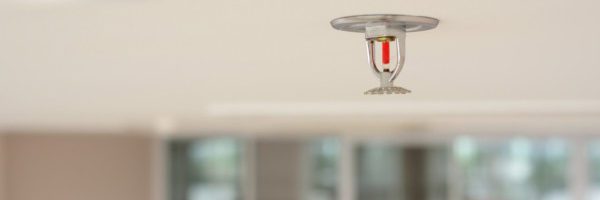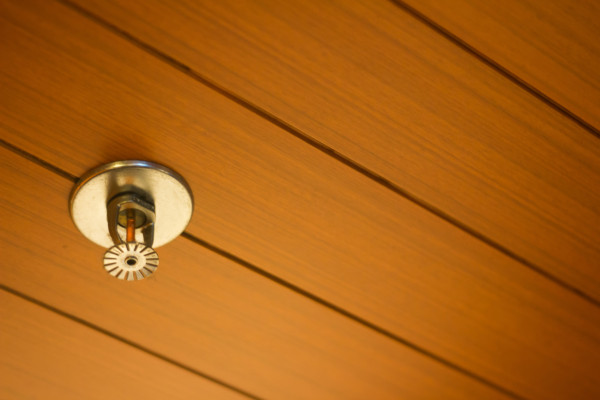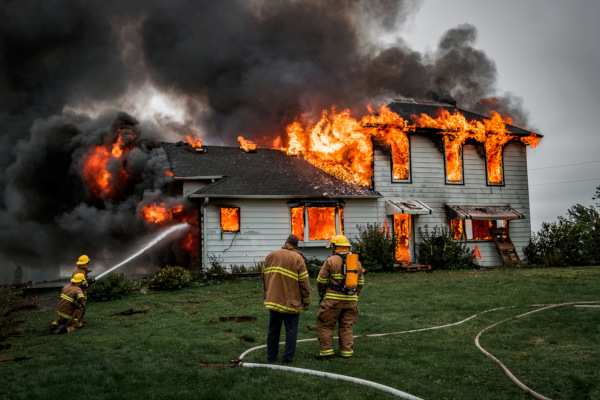The True Cost to Install a Residential Fire Sprinkler System

Adding a residential fire sprinkler system to a house isn’t an expensive proposition—and there are ways developers and AHJs can make it easier
It’s an indisputable fact: residential fire sprinklers save lives and property. National Fire Protection Association (NFPA) model codes and the International Residential Code (IRC) mandate fire sprinklers in all new one- and two-family homes. But concerns about the expense stop many states and communities from implementing the requirement.
When home fires occur, they are more dangerous than ever. The widespread use of lightweight, synthetic materials in modern homes has fires burning hotter and faster, leaving people as little as two minutes to escape. While the overall number of residential fires has dropped dramatically in the past 40 years, the death rate per 1,000 home fires was higher in 2016 than in 1980.
Watch this video from UL (formerly Underwriters Laboratories) to understand how much faster modern home materials burn:
Working residential fire sprinklers control fires 96% of the time, according to NFPA.
Case in point: After adopting residential sprinkler requirements, Bucks County, PA, reported zero fire deaths in sprinklered homes over 22 years and a 93% average reduction in property damage.
Despite these compelling statistics, fire safety professionals often face an uphill battle to convince legislators to adopt model code requirements to install this life-saving technology in new homes. The opposition generally comes from home builders, realtors, and even some residents who argue that fire sprinkler mandates will make homes unaffordable to many buyers.
Let’s take a look at the real costs involved in installing and maintaining a residential fire sprinkler system. We also explore how well-intentioned authorities having jurisdiction (AHJs) can slow the adoption of residential sprinklers by adding unnecessary additions to model code requirements.
The true cost to install sprinkler systems in homes
NFPA 13D: Standard for the Installation of Sprinkler Systems in One- and Two-Family Dwellings and Manufactured Homes is a practical document. It emerged from years of study aimed at modifying the stringent requirements of NFPA 13: Standard for the Installation of Sprinkler Systems into a set of rules that create affordable, effective fire protection systems for homes.
The average expense to install sprinkler systems in new homes is about $1.35 per square foot. With the average construction cost of a single-family home at $114 per square foot in 2019, that’s paying a little more than 1% of a home’s value for 24/7 fire protection. When the expense is spread over a 30-year mortgage, it’s less than the price of a cup of coffee per week.
Of course, homes aren’t exclusively priced by the cost of installing systems like sprinklers or plumbing—they are valued at what the market can bear. But to put the incremental cost of life safety in perspective, consider that people pay similar or significantly higher amounts for common upgrades, which are never cited as barriers to homeownership.
The average price of a kitchen remodel is $25,093, or $150 per square foot. Installing wall-to-wall carpet costs roughly $3 to $7 per square foot. Insulating an attic runs about $1.50 to $3.50 per square foot. And none of these value-adding amenities both increase the resale value of the home and save lives.
The $1.35 figure is significantly less than the average $1.61 per square foot cost reported in a 2008 study of home sprinkler installations. Most likely, the decrease reflects rising competition among installers, improved installation methods, NFPA standards aimed at lowering home sprinkler costs, and the adoption of ordinances requiring home sprinklers in more communities.
Keep in mind that the number is just an average: the actual cost will vary based on location and structure. For instance, the average cost to install sprinkler systems in homes is as low as $0.81 per square foot in Fresno, CA, and as high as $2.47 in Greenburgh, NY. Mitigating factors include which piping materials are used in the system (CPVC, PEX, black steel, or copper) and the local water supply, extent of coverage, type of home, permit and inspection fees, and existence of statewide sprinkler requirements.

74% of U.S. homeowners say they’re more likely to buy a home with fire sprinklers.
The National Association of Home Builders claims that government regulations account for 24.3% of the final price of a new single-family home. But fire sprinklers are only a small fraction of such requirements. And trade-up incentives for installing fire sprinklers in new residential subdivisions can actually help lower construction costs and increase profits for builders or achieve cost neutrality. These incentives give “credit” for the presence of automatic fire sprinkler systems, allowing developers to avoid having to comply with other fire protection safety requirements during design and construction.
Typical incentives include:
- Street-width reductions that substantially reduce the amount of pavement in every linear foot of street.
- Longer dead-end streets that allow access to additional building lots.
- Permission to use tee turnarounds that create at least one additional lot per cul-de-sac.
- Additional units because homes can be closer together.
- A single subdivision access point.
- Greater spacing between fire hydrants and fewer supply mains.
- … and more.
Residential fire sprinklers can enhance the marketability and resale value of a home, as well. “A national poll conducted by Harris Interactive®” found that nearly three-quarters of U.S. homeowners (74%) say they’re more likely to buy a home with fire sprinklers. And 69% said they see sprinklers as a value-added amenity.
Insurance companies also recognize that residential fire sprinklers reduce fire damage, offering discounts ranging from 5% to 30% off the fire portion of homeowners’ policy premiums.
Home fire sprinkler maintenance is minimal—and most of it is common sense
Some groups resist residential fire sprinklers on the premise that maintenance will be too difficult or costly. But while commercial systems do involve strict, detailed maintenance requirements, the opposite is true for residential fire sprinklers.
In fact, NFPA created its home sprinkler requirements with a single goal in mind: save as many lives as possible through widespread sprinkler adoption. The resulting NFPA 13D standard paves the way for reliable, lower-cost, and virtually maintenance-free systems.
With minimal, commonsense steps, residential fire sprinklers are designed to last for decades. Installers generally give homeowners specific instructions for maintaining and testing their systems. Essential steps include:
- Regularly open the system test valve to ensure water flows and any connected alarms work. Guidance for performing this test ranges from every month to every year.
- Once a month, perform a visual inspection of sprinkler heads and any exposed piping and valves. Make sure furniture or other objects won’t obstruct a sprinkler’s water spray.
- Winterize sprinkler pipes like any water pipes in a cold area.
- Make sure the control valve is always left open, so the sprinkler works in an emergency. In the rare cases that sprinkler systems fail to operate, lack of water is the primary reason—62% of home sprinklers that failed were simply shut off.
- Don’t hang anything from a sprinkler. Hanging items can accidentally trigger sprinklers or block water delivery.
- Don’t paint sprinklers. Even a little overspray or paint splatter can delay or prevent activations.
- Damaged sprinklers should be replaced quickly by a qualified sprinkler contractor.
Need further evidence that sprinklers are easy to maintain? Thirteen years after Scottsdale, AZ, passed its automatic residential sprinkler ordinance, a follow-up survey found that only 11% of respondents had experienced any maintenance problem. 100% stated that their fire sprinkler systems remained in working order.
Watch this video for more residential fire sprinkler system do’s and don’ts:
AHJs can drive the installation residential fire sprinklers by relaxing additional requirements
At its essence, NFPA 13D is a life safety standard—it focuses on protecting life before property. The standard emerged from a startling revelation in the 1973 report, “America Burning: The Report of the Commission on Fire Prevention and Control,” that still holds true today: an overwhelming majority of fire deaths occur in the home. The need for residential sprinklers remains clear.
But sometimes, well-intentioned AHJs can slow the adoption of residential fire sprinklers by adding requirements that fall outside the scope of NFPA 13D and increase system costs. These requirements—such as sprinklering residential garages or (unnecessarily) increasing pipe sizes to get more water onto fires—are intended to help preserve property.
But between 2010 and 2014, residential fire sprinklers were only present in 7% of home structure fires. And without widespread adoption, a civilian dies in a home fire every three hours and 20 minutes.
With cost repeatedly cited as the biggest obstacle to the acceptance of residential sprinklers, prioritizing the most inexpensive systems that reduce home fire risk is essential. And the struggle is ongoing to convince communities that residential sprinkler systems are key to a safer future.
While this debate continues, AHJs can help pave the way for more installations by keeping additional requirements that don’t exclusively further the goal of life safety to a minimum.
For step-by-step guidance and resources that can help communities take on and win the battle for residential fire sprinkler requirements, read NFSA’s guide: “Residential Fire Sprinklers: A Step-by-Step Approach for Communities.”

Despite overwhelming evidence that residential fire sprinklers save lives and property, they’re only present in 7% of home structure fires.
For more information and to be put in touch with a qualified sprinkler professional who can provide a system quote, please visit FireSprinklersBuyLife.com.
For over a century, the National Fire Sprinkler Association (NFSA) has served as the voice of the fire sprinkler industry. Our mission: advocating to protect lives and property through the widespread acceptance of the fire sprinkler concept. To join NFSA or learn more about the ways membership can benefit your organization, visit nfsa.org/join.
